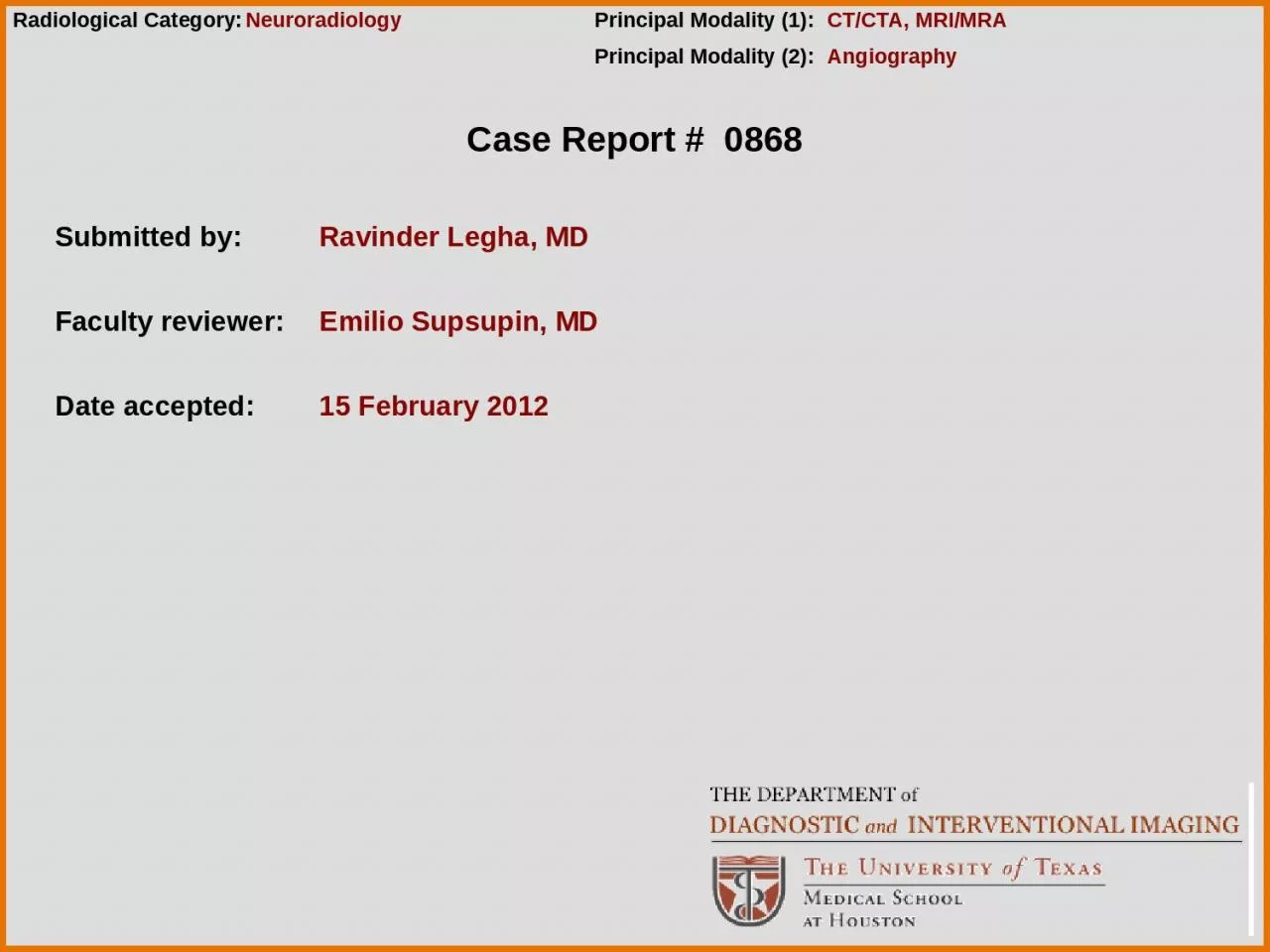

Ravinder Legha MD Faculty reviewer Emilio Supsupin MD Date accepted 15 February 2012 Radiological Category Principal Modality 1 Principal Modality 2 Neuroradiology Angiography ID: 914785
Download Presentation The PPT/PDF document "Case Report # 0868 Submitted by:" is the property of its rightful owner. Permission is granted to download and print the materials on this web site for personal, non-commercial use only, and to display it on your personal computer provided you do not modify the materials and that you retain all copyright notices contained in the materials. By downloading content from our website, you accept the terms of this agreement.
Slide1
Case Report # 0868
Submitted by:
Ravinder Legha, MD
Faculty reviewer:
Emilio Supsupin, MD
Date accepted:
15 February 2012
Radiological Category:
Principal Modality (1):
Principal Modality (2):
Neuroradiology
Angiography
CT/CTA, MRI/MRA
Slide2Case History
8 year-old male with no past medical history presents with progressive headache and left sided weakness.
Slide3Radiological Presentations
Slide4Radiological Presentations
Slide5Radiological Presentations
Slide6Radiological Presentations
Slide7Radiological Presentations
Slide8Radiological Presentations
Slide9Intramedullary neoplasm
Spinal hemangioblastoma Vertebral artery fistula
Spinal AVM (type III)
Which one of the following is your choice for the appropriate diagnosis?
After your selection, go to next page.
Test Your Diagnosis
Slide10-CT:
-Brain: unremarkable
-Cervical spine: craniocervical
hematomyelia with a hematocrit
level.-MR: -MRI Spine: Abnormal tangle of dilated, serpiginous
flow-voids within substance of cervical cord extending into craniocervical junction, with a nidus
extending from tip of the dens to base of C2. Expansion of the cervical cord, particularly at the level of the abnormal vessels, with effacement of the CSF space posteriorly. Hemorrhage within the cord. Associated edema extends from caudal medulla to C5-6 junction. Areas of enhancement are related to differential rates of flow through the dilated vessels.
-MRA head/neck: feeding vessel is the anterior spinal artery originating from the right vertebral artery
Findings:
Findings and Differentials
Slide11-Angiography
-Left vertebral artery: Dilated tangle of vessels at the craniocervical junction fed by a dilated anterior spinal artery and drained by the coronal venous plexus into the
dural venous sinuses, as well as directly into the internal jugular veins. The portion of anterior spinal artery feeding the tangled vessels originates rostrally from the V4 and also caudally from V1.
Intramedullary
neoplasm
Spinal hemangioblastoma Vertebral artery fistula
Spinal arteriovenous
malformation (type III)
Findings:
Differentials:
Findings and Differentials
Slide12-Arteriovenous
malformation A direct arteriovenous communication without intervening capillary bed. <10% of spinal masses. Can be sporadic or
syndromic-Imaging findings: -MR: -T1: low signal (edema) in type I and IV. Heterogenous
signal (blood) in type II-III. Flow voids from enlarged arterial feeder +/- draining vein. -T2: cord swelling and intramedullary
high signal due to venous hypertension and edema. Serpiginous flow voids due to dilated perimedullary venous plexus. SC may be displaced or compressed by venous varices
in extradural AVMs.
-T1C+: may see enhancement of distended perimedullary venous plexus (types I-IV) +/- AVM nidus in type II and III.
-CTA: dilated, tortuous perimedullary
veins +/- enlarged radiculomedullary artery (type I) or spinal artery (types II-IV).
-DSA required to confirm diagnosis and to classify/define angioarchitecture.
-Clinical presentation depends on AVM type: progressive paraparesis, pain, acute neurological deficit.
Discussion
Slide13-Classification/DSA imaging findings.
-Type I (80%): thoracic. solitary arterial feeder (dorsal radiculomedullary artery) shunting into a dilated coronal venous plexus in the subarachnoid space, which drains into epidural veins distal to fistula.
-M>F, 6th- 7th decade. Good prognosis. Progressive myelopathy. Hemorrhage rare.
-Tx:
Embolization or Surgery. -Type II/Glomus type (10%): Cervical/upper thoracic. supplied by ASA +/-
posterolateral spinal artery, nidus drains to coronal venous plexus (on cord surface), which drains into epidural veins.
-Compact or diffuse intramedullary
nidus within SC lacks capillary bed +/- feeding artery/intranidal aneurysms. No parenchyma within
nidus.
-Assoc with cutaneous angiomas
, Llippel-Trenaunay- Weber, Rendu
-Osler Weber syndromes. -M =F, 20-40 yo. SAH most common symptom. Pain, myelopathy
. -Tx
: Surgical resection, pre-op embolization (aneurysms, nidus
).
Discussion
Slide14-Classification/DSA imaging findings (cont):
-Type III/Juvenile (5%): Cervical/upper thoracic. Large complex intramedullary nidus
, which contains normal neural parenchyma. May have extramedullary or extraspinal component. Multiple feeding vessels +/- feeding artery/intranidal aneurysms. Additional soft tissue AVMs possible.
-Associated with Cobb syndrome (metameric vascular malformation involving triad of spinal cord, skin, bone).
-M=F, <30 yo. Progressive neurologic decline (weakness). SAH. Poor prognosis. -Tx
: Complete resection usually not possible; palliative therapy with embolization +/- surgery to relieve cord compression.
-Type IV: Conus
medullaris or thoracic. Direct fistula between ASA/PSA and coronal venous plexus without nidus
. -Associated with Osler-Weber-Rendu
. -M=F, 10-40 yo
. Progressive conus/cauda
equina syndrome, SAH.
Discussion
Slide15-Differential Diagnoses
-Intramedullary neoplasm:
-Ependymoma: heterogeneous (cysts, blood products), variable enhancement. -Astrocytoma: multisegmental enhancing mass, no enlarged vessel.
-Spinal hemangioblastoma:
-Intramedullary tumor blush supplied by ASA, PLSA. -Sporadic or associated with VHL.
-Vertebral artery fistula: -Single-hole AV fistula between vertebral artery and adjacent veins +/- reflux into epidural veins.
-Usually seen in penetrating injuries, iatrogenic during surgery. -Vertebral body metastasis: -Pathological tumor blush +/- AV shunting within spinal,
paraspinal soft tissues. -
Hypervascular skeletal metastases from renal cell ca, thyroid ca, melanoma.
Discussion
Slide16Type III
arteriovenous
malformation of the craniocervical spinal cord with hematomyelia.Preoperative
embolization was deferred. The lesion was partially resected.
Diagnosis
Slide17c
Caragine
LP
Jr at al: Vascular myelopathies-vascular malformations of the spinal cord: presentation and endovascular surgical management.
Semin Neurol. 22(2):123-32, 2002.
Spetzler RF et al: Modified classification of spinal cord vascular lesions. J Neurosurg
. 96 (2 Suppl):145-56, 2002
www.statdx.com
Yousem
DM et al: The Requisites: Neuroradiology. 3rd
edition: 571-571, 2010 Type III arteriovenous malformation of the craniocercical spinal cord with
hematomyelia.
References